29 Proven Strategies To Flow Customers Through Your Sales Funnel (Especially If They’re Stuck!)

Sometimes your sales funnel just doesn’t work, even when you’re doing everything right.
Take us, for example: in the first month of 2018, we only generated $900 in business.
If we hadn’t changed anything, sales might have only grown modestly (or not at all).
I think we’ve all found ourselves in that position at one point or another.
You’re checking all the boxes, you’re doing everything you’re “supposed” to do.
But still, no conversions.
Instead of banging your head against the wall, wondering where you’ve gone wrong, let me help you out.
With a few tweaks to our funnel, we were able to significantly up our conversions—and now our revenue is up to almost $6k a month.
Many of the tricks we used are in this article. I guarantee that if you give them a try, you can find your problem and fix it with minimal time or effort.
I’m sharing over 29 fixes for the most common problems I see, from start of your pipeline all the way to the end.
Now let’s jump in and get that funnel working!
Attract and Engage
The first step in any effective sales funnel is to attract and engage an audience. And if they’re getting stuck here, well … you’re not going to sell very much.
But without this critical first step, you literally have nothing.
Luckily, this is the simplest issue to fix. Here’s how.
1. Reconsider Your Target Audience
We’ve talked about target audience a lot, and for good reason. If you don’t understand your ideal customer, you don’t know how to target your marketing. If you don’t know how to target your marketing, you’re not going to sell anything.
Your sales funnel may be stuck because you’re simply targeting the wrong people. Sure, they might visit your website or read your blog posts, but in the end, they’re not going to buy anything.
![]()
And why is that?
Because they don’t have the problem that your product or service solves.
It’s possible that when you first created your marketing plan, you didn’t properly determine your target market. Or, maybe your products/services have changed and that market is no longer suitable.
Take a step back and reassess.
Start over from the beginning and think about who would need your product. What type of person are they? What field do they work in? What age are they? Where do they live? What are their hobbies?
You know the drill.
2. Increase Brand Awareness
Brand awareness is one of the first steps in turning leads into customers.
It means you are letting people know what you do and how you’re better than the competition.
Without it, you have no business.
James Caan said,
“You can have the best products in the marketplace or provide the best possible service, but you will get nowhere if you have [a low] profile or a weak brand.”

Yes, that James Caan. I don’t really know what he has to do with marketing either, but he makes a good point.
A strong brand helps you stay top-of-mind in your market.
It means that when someone is in need of a product or service that you offer, your business is the first one they’ll think of.
You don’t want a potential customer to choose to do business with someone else just because their brand is more recognizable, right?
Some quick and easy ways to up your brand awareness are:
- Create and share infographics
- Guest post on other blogs
- Publish articles on LinkedIn
- Run a podcast
- And, the #1 most important thing: be UNIQUE. Don’t try to mimic the other guys, no matter how well they’re doing.
3. Boost Visibility
Marketing today is complex.
There are a ton of people doing to same thing that you do, and they have access to all the same marketing channels as you.
Let’s face it–with social media, anybody can get their name out there.
One of the keys to an effective sales funnel is to make yourself stand out. To make yourself even more visible than the other guys.
Enter The Law of Visibility.
All this law says, really, is that “offers must be seen for sales and conversions to occur.”

Take a look at your emails, blogs, and website and see if your offer is clear. Are you even including your offer in every outreach channel?
If not, fix it by putting your offer at the beginning of content or in plain sight so your audience doesn’t miss it.
4. Use Social Media to Nurture Prospects Into Leads
EVERYONE is on social media today.
Your best friend, your cousins, your great aunt Irma.
Your potential customers.
Social media is important throughout your sales funnel, but perhaps is most important up front.
If you find that people are becoming “stuck” right in the beginning, meaning they’re not ever visiting your website or converting into email subscribers, then social could be your problem.
Today’s consumers expect a brand to be active on social media.
They want to see you posting quality content, they want to see others commenting on your posts, and they want to be able to ask questions and interact with you.
If you’re not doing that and your competitors are, then your prospects might just be moving on to the next best thing.
5. Revamp Your Website
So, you spent thousands of dollars on a fancy website, but no one is buying anything.
You know they’re visiting–you can see it in your analytics.
What’s going wrong?
There is a common misconception that just having a website is enough. It’s not.
Everyone has a website.
You may have the best products, but if you don’t
stand out, it doesn’t matter.
Here are some reasons your audience might be
stalling out on your webpage:
- Too many ads. I don’t know about you, but if all I see is pop-ups and ads, I’ll leave a page. Immediately.
Inc. is by far one of the worst offenders, in my opinion. Between the banner at the top of the article, the ad on the right, and the pop-up in the bottom left corner, it’s almost impossible to read anything.
And they don’t go away! They’re on every single page, and they stay there the entire time.
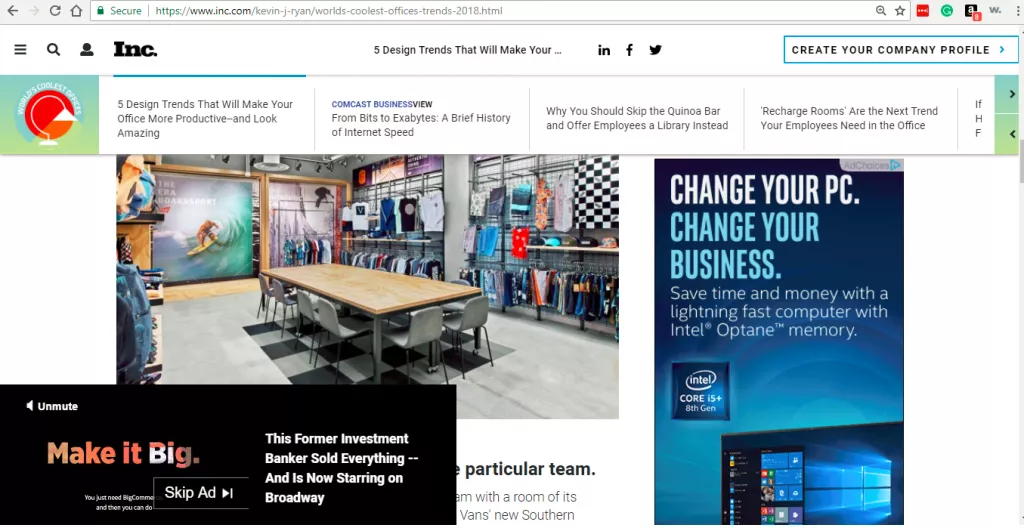
- Slow load times. Do you know how long it takes a visitor to decide whether or not to stay on your page? 2.6 seconds. If your site takes 5 seconds to load, they’re gone before they ever even see anything.
- Poorly designed navigation. Imagine someone reads one of your blog posts, they’re interested in your products … and then they arrive on your site and can’t find your purchasing page. Ouch. Your poor site design just cost you a sale.
- No pricing information. Not listing your prices just SCREAMS “expensive.” It doesn’t matter how interested a prospect is in your product or services–if they can’t find how much it costs, they’re not going to move on.
6. Engage in Email Marketing
Email is still one of the most effective ways to attract new leads and convert them into customers.
Why? Well, people appreciate quality content and useful information. And they love to have it
delivered straight to their inbox.
Think about it: what’s the first thing you do every morning?
If you’re like me, you pick up your phone and check your email before you even get out of bed.
If you’re not utilizing an email newsletter, you’re missing out on a great chance to help nudge people through your funnel.
7. Employ Surveys
No one knows what your prospects want better than they do.
Surveys can be used to determine pain points, needs, interests, demographics–really anything that you think might help you better target your offers.
And after surveying just a handful of clients, you may get a clearer picture of why they stop progressing through your funnel.
Maybe they’re sold on your product, but they can’t afford the cost right now. Maybe they like your ideas but aren’t really sure how they’d be of benefit. Maybe you’re not even offering the services that they need at all.
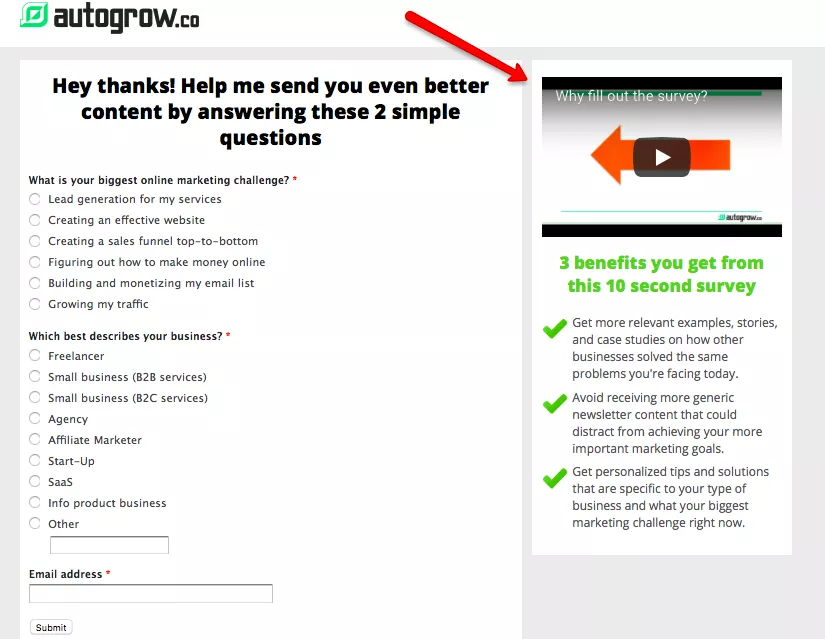
Knowing the issue makes it easier to fix.
Find out how we used a survey funnel to up our interaction rate by 28%.
8. Create Engaging (Better!) Content
If you used to see some really great conversion, but now it’s waned … well, it might be that your content just isn’t that good anymore!
The blogosphere offers a lot of competition and (like everything else I’ve mentioned so far) if someone else is doing better, they’re going to get the business.
It’s quite possible for you to have a great social media presence and a perfect landing page, but when your prospects go check out your blog they’re less than impressed.
If they find articles that are boring and uninformative or–worse–full of errors, do you think they’re going to want to do business with you?
If you can’t take the time to create quality content on your own blog, how are you going to perform for your customers?
9. Use SEO Best Practice Consistently
Maybe this one should have been at the top of the list. Because, really, without SEO, you’ve got nothing.
Forget leads getting “stuck” in your sales funnel–they’ll never even get there in the first place.
If you want to attract an audience to your website, your blog, whatever, search engines need to be able to find you.
Here are some easy ways to implement SEO without a ton of effort:
- Plug keywords into your content–but in a user-friendly, readable way. Don’t be obnoxious about it!
- Be consistent. Stick to your main topic(s) and don’t veer too far off course. It’s hard to rank when you’re writing about 600 different things.
- Utilize crosslinks. Use your blog to link to other pages or articles within your own site that are related to the same topic.
- Know your audience! Google knows how many people visit your site, how long they stay there, and how often they share your content. The more search engines think people dig your work, the higher they’ll rank you.
10. Use Analytics
If you’ve read through all of this, but you’re still not really sure what the issue is, understanding your analytics might help.
Google Analytics makes it easy to get some basic information on your traffic and their behavior. Using that info, you can adjust as necessary.
Here’s what you should check:
- Demographics Report: Say your target audience is college-aged females. Go to Demographics<Overview. There you can see the general makeup of your audience. If it’s mainly made up of 60-year-old men, your site is probably missing the mark somehow.
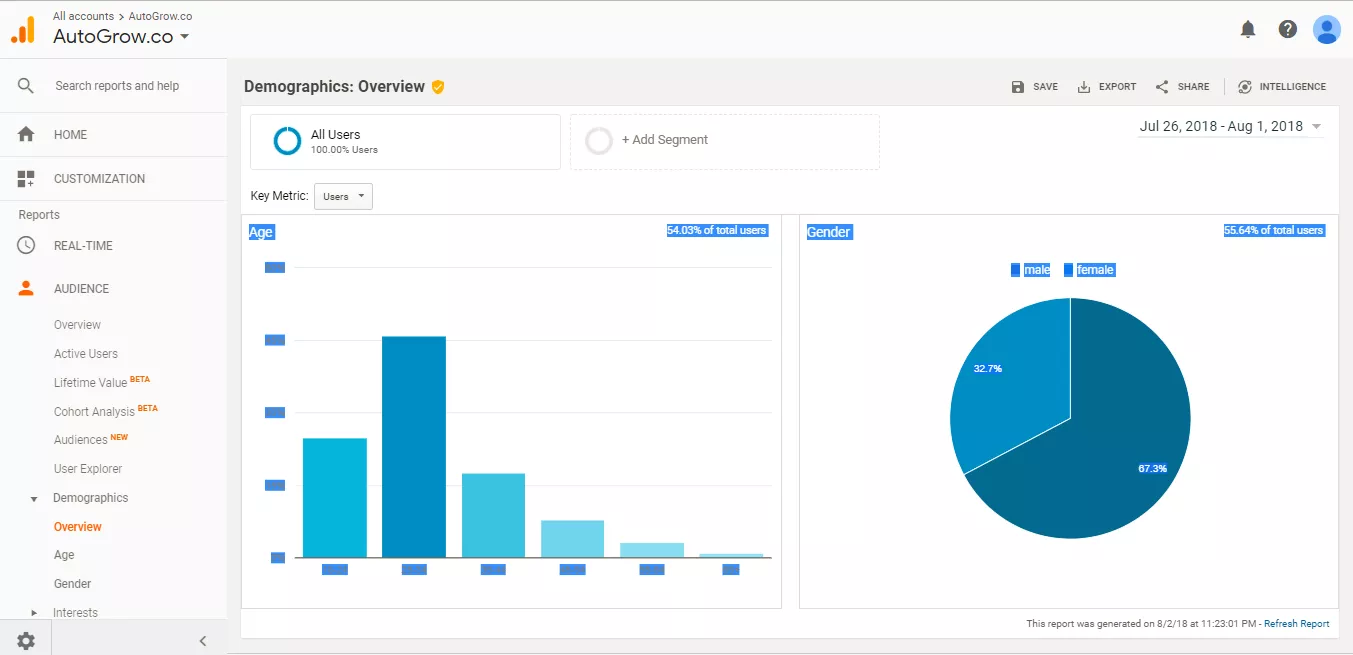
- Acquisition Channels Report: Here, you can see how visitors are arriving on your site. If 80% of your traffic is arriving via organic search, and only 5% is arriving via social media, then you need to up your social presence.
- Bounce Rate: Your bounce rate is the number of visitors who left your site after viewing only one page/number of total visits. This can mean a few things:
- The traffic is of poor quality
- Your landing pages aren’t optimized
- Your website isn’t user friendly
Nurture Your Leads (Middle of The Funnel)
Lead nurturing means taking people that have already showed some level of interest and nursing them until they’re ready to buy.
It’s where a lot of business owners fall short.
Attracting leads, which we already discussed, is fairly easy
The most time-consuming part, really, is creating original content on a regular basis. But even that shouldn’t take more than a couple hours a week, tops.
It’s keeping their interest that’s tough.
Once a lead is this far into your funnel, they’ve seen your content. They know what you’re all about. They probably know most of the tricks you have up your sleeve.
So how do you keep them intrigued? How do you keep those leads moving through the funnel?
11. Use Fresh Content to Get Stale Leads Excited Again
Leads require constant engagement and information to move them forward. Chances are, you’re not sending the right messages at the right time.
One fix is to add more content to your nurturing sequence.
Consider increasing the frequency of your email messages, adding in more special offers, or developing more calls-to-action for the various stages of your funnel.
Take Instapages, for example. Instead of purging 55,000 non-responsive contacts from their system, they decided to up their game.
In fact, they drove $30,000 in recurring income in less than 2 months.
How? Well, it all started with a little wager:
“Launch a lead nurturing journey and you’ll make the money back you’d save from downgrading plans. If you don’t, we’ll give you a refund.”
And it worked! It was exciting, it was fun, and it got those stale leads interested in their product again.
Another issue, and one that’s fairly easy to fix, is your overall design.
I discussed this in a recent Matt Hack video we shared.
By updating the design and content of our Six-Figure Sales Funnel landing page, I was able to increase sales by 34%.
12. Use CRM to Create a Personalized Experience
The power of personalization is undeniable.
In fact, according to one Boston Consulting Group study, “Brands that create personalized experiences by integrating advanced digital technologies and proprietary data are seeing revenues increase by 6% to 10%.”
Can you afford to miss out on that?
Here are some of the ways you can use CRM to move people through your funnel:
- Customize landing pages based on the opt-in or ad the visitor used to get there
- Use qualifying questions to help customize the experience (for example, “How are you planning on using this product?”)
- Use login information to track interaction choices and suggest appropriate products/services
- Retarget customers who abandoned their cart
Bottom line: CRM allows you to anticipate and understand customer needs in the moment–and that leads to better conversion.
13. Leverage Social Proof
Say you’re in a strange city and you’re looking for a place to eat.
What do you do?
You probably stop in the restaurant with the most people in it, right? They wouldn’t all be there if the food wasn’t good!
That’s social proof.
People look to other people to show them what to do in any given situation.

The same is true of your business–if your audience sees other people interacting with you, buying things from you, or leaving you glowing reviews, they’re more likely to do the same.
How do you gain social proof?
- Ask past customers for testimonials
- Create affiliations or partnerships with other well-known brands
- Increase engagement using tools such as surveys, contests, or quizzes
- Display the number of users or downloads on your page (for example, “Over 3,500 Users Have Already Downloaded This Free Tool!”)
- … and much more! A little Google search can turn up lots of ideas.
14. Use Social Media to Answer Questions
Engagement is a great indicator of overall success.
The more you engage with your audience, the more likely they are to do business with you.
And answering questions is an easy and effective way to spark engagement.
Social media allows you to be where your customers are in real time. No sitting on the phone and waiting or sending an email and never getting a reply.
You can have a quick back-and-forth immediately, with little effort.
Your answer might squash any doubt or reluctance your potential customer was feeling, giving them that final nudge they needed to buy.
Even better: when you interact with someone on Facebook or Twitter, the exchange is visible to everyone else who stops by. That’s some amazing social proof.
15. Provide Gated Content
What is gated content?
Cliffs Notes version: it’s asking for details such as an email or phone number in exchange for valuable content.
It allows you to vet leads and contact those who have a genuine interest in your product–and it’s a powerful tool in your marketing arsenal.
If you notice a lot of people getting “stuck” in your funnel, the fact is that they may just not be very interested.
Stop wasting your time on them.
If you can get leads to give you personal information, there’s a good chance they’re serious about your product. Focus on those instead.
Focus on Conversion (Bottom of The Funnel)
This part is really about answering questions.
People are already aware of you and what you do. Now they need convincing.
16. Build Rapport
A 2015 CBS/New York Times poll asked, “What percentage of people in general are trustworthy?”
The answer? 30%.
But when they rephrased the question to ask, “What percentage of the people that you know are trustworthy?” the answer jumped up to a staggering 70%.
Moral of the story? When people know you and like you, they’re more likely to do business with you.
Here’s how to build rapport:
- Be genuine
- Share quality, useful information (DON’T be too salesy)
- Show interest in what the audience has to say
- Don’t be pushy–experiment with how many emails you send to find the right balance
17. Show Expertise
When given the choice between two businesses, the customer is always going to pick the one that demonstrates more know-how.
The one that is proven in proficiency.
Luckily, it’s easy to display expertise–even if you have no proof.

The gurus over at Duct Tape Marketing say to rely on the “Three Ps”:
- Publish: demonstrate your expertise through your blog, your newsletters, and your social media content.
- Partner: team up with other businesses in the same niche and see how you can be of service to their clients or offer to guest blog.
- Podium: create a valuable presentation and then offer to speak at groups, or even share your work online via YouTube or Facebook.
If you really know what you’re doing, it’ll be evident through your passion and dedication.
18. Provide Value
We all like a great bargain, right?
When someone is thinking about doing business with you, they want to feel like they’re getting the most bang for their buck.

What are some great ways to do that?
- Understand what is important to your customers and what constitutes “value” for them.
- Know your value proposition. That is: the benefits the customer receives from purchasing your product or service, minus its cost.
- Identify ways in which you can create value relative to your competitors.
19. Optimize Landing Pages
Landing pages are sort of a make-or-break opportunity.
If you’re doing them wrong, you risk missing out on sales or even offending your audience.
But if you’re doing them right, you stand to gain off-the-charts conversions and life-long customers.
Here are the basics:
A landing page should discuss the benefits of the product or service you want to sell and present all the information a prospect needs to convert.
It should also provide a strong call-to-action and make it easy to purchase immediately.
What should it not do? Get too wordy. Discuss unrelated products or services. Try to “shame” the reader into buying.
20. Get The Most Out of Your Blog Posts
According to research by Statista, B2B marketers thought that blog posts were the most valuable content in terms of moving prospects through the sales funnel.
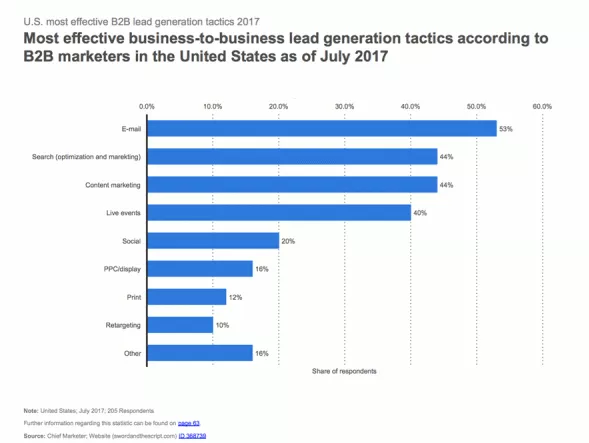
When writing a blog post for conversion purposes, do the following:
- Know your audience. Understand what they’re looking for and what they need.
- Break the content into easy-to-digest sections with subheadings and bullet-points.
- Discuss key benefits and features.
- Add relevant images.
- Include a direct call-to-action or a way to purchase.
21. Answer Frequently Asked Questions
My theory?
If prospects can easily find the answers they need on your website, they won’t search elsewhere (like a competitor’s site).
Over the years, I’ve learned that an effective FAQ section should be written by your customers, not you.
Why? Because FAQs need to be written in a voice your customer understands. It helps them get “off the fence” about buying your product.
If you’re not sure where to start, try some universal questions.
Check out your competitors’ sites and write down the 10-most commonly asked questions. From there, think about what information you can provide that they did not.
[caption id="attachment_20033" align="aligncenter" width="482"]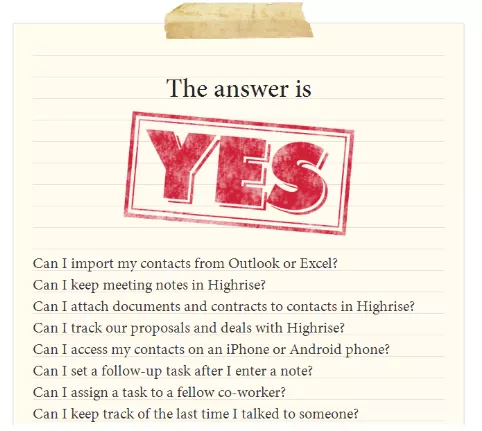 This FAQ page from Highrise is a great example of how to include all the relevant information in a creative way.[/caption]
This FAQ page from Highrise is a great example of how to include all the relevant information in a creative way.[/caption]
And remember to include a call-to-action on your FAQ page. The idea here is to get leads “un-stuck,” so you have to provide a way for them to purchase!
Check out my article 10 Tips to Write An FAQ That Gets Customers “Off The Fence” & Grows Sales for more in-depth information.
22. Leverage Online Reviews
According to Socialnomics, even the best written sales copy is not going to be as effective as positive testimonials from your customers in convincing others to buy from you.
In fact, 92% of consumers read online reviews before making a purchasing decision.
72% of them say that positive reviews make them trust a business more.
So if a prospect is on the fence about purchasing and they can’t find any reviews on your website, what do you think will happen?
They’re going to go buy something from the guy that does have reviews.
Some places you can share positive reviews include:
- Social media
- Paid ads
- Website (home page, blog, about screen, everywhere!)
- Newsletter
- And so on. Pretty much anywhere you’re posting content.
23. Share Case Studies
I’ve said this before and I’ll say it again–case studies can win you customers.
A good case study shows how you’ve helped other people solve an issue like the one your prospect is currently having.
It shows them that your product or service is useful and it does work.
And don’t worry! If you’re brand-new to business and you don’t have your own case studies yet, it’s ok to share someone else’s.
The key? Show your prospects how something worked for the other guy–and then tell them how you’re going to do it even better.
24. Introduce Urgency
If you really want to get someone off the fence, make them feel like time is running out.
People hate to feel like they’re missing out on a deal, or like someone else is going to get something that they don’t have.
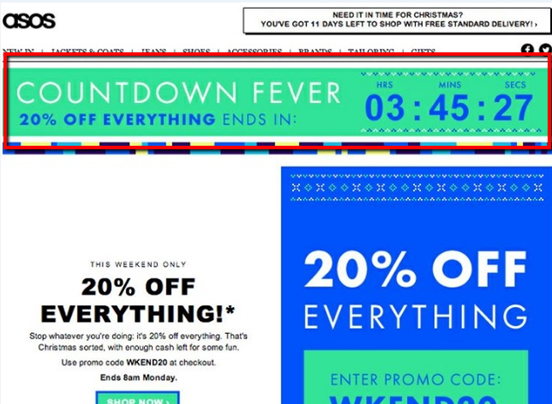
It’s exactly why someone might be willing to spend $150 on a used Nintendo Gameboy on Ebay.
“Oh my God! Time is running out! What if I never see this deal again?”
You can introduce that same sense of urgency into your sales funnel through the use of financial incentives or limited-time offers.
Some ideas include:
- Free shipping or a special discount if you purchase within x amount of time
- An add-on or limited-edition giveaway only available to the first x amount of buyers
- Sell only a limited amount of your product, or offer your services to only a limited number of people before cutting off sales
- Offer your product on a rolling basis
As an example, we decided to offer our most premium product, Six-Figure Sales Funnel Training, only once per month.
Now, instead of being available all the time, there is only a brief window every month when it can be purchased.
25. Place Cold Leads on The Back Burner
What happens when “good” leads stop responding?
They clog up the funnel.
It makes sense to try for a little while, but eventually it just becomes a waste of time and energy.
Worse: trying to nurture an obviously cold lead takes time away from other prospects who may be interested in buying

You may want to stop contacting someone if:
You’ve reached out 5 times or more with no response
- They haven’t opened your emails in over 30 days
- They repeatedly try to haggle on price
- They download all of your freebies, but never actually purchase anything
- They’ve actually told you they’re not interested
Build Loyalty (Maximize Lifetime Value)
Once you’ve “un-stuck” your funnel and converted some of those leads, you’re going to want to build loyalty so they stick around and KEEP buying.
And further–loyal customers spread the word about your business, they stick with you (even when you try out some not-so-great ideas), and they come back to purchase more often.
Here are some ways to encourage loyalty for the long-haul.
26. Offer Exclusive Deals
You can create an even stronger bond with your customer base by rewarding them with “loyalty” discounts.
Supermarkets, chain stores, and restaurants have been cashing in on this for years.
I’m sure everyone reading this belongs to Walgreens Balance Rewards or MyPanera, right? Or at least something like that.
The general idea is that you “earn” money by spending money.
Why not leverage something similar in your own business?
Allow your customers to earn discounts, exclusive products, or early-bird shopping just because they’ve done business with you in the past.
27. Provide Referral Offers
This could really fall under “attract and engage” or “build loyalty.”
First, people are more likely to do business with you when they’re referred by a friend or family member. Four times more likely, actually.
Second, when you offer a referral bonus to a current customer, you gain their loyalty by offering something of value. Plus, let’s be honest here–if you do a great job for the friend, you’re going to score crazy brownie points.
And a referral bonus doesn’t have to be anything off-the-wall. Typically, it’s something like a certain percentage off the next bill or a discount on a future purchase.
28. Partner With Influencers
As a business owner, you should have at least a vague idea your audience’s interests outside of your business (what they do for fun, if they have pets, what sort of entertainment they enjoy, etc.).
Leveraging that information to create exclusive deals could lead to increased loyalty and repeat sales.
Partner with their favorite influencers to offer:
- Coupons or discounts to stores or restaurants
- Exclusive content (videos, songs, images)
- Promo codes for the influencer’s products/services
29. Provide Exceptional Customer Service
As my last tip here, I’m going to talk about good old-fashioned customer service.
Frankly, this is something that a lot of businesses are lacking today and it can mean SO MUCH.
I mean, a customer might decide to work with you or not work with you just because of your customer service. It’s that important.

That being said: customers remember when they’re treated well.
They’ll keep coming back to do business with you, they’re more likely to forgive errors, and (most importantly) they’ll tell their friends and family about you.
Bonus Tip: Use The Law of Big Changes
A while back, I talked about The Law of Big Changes in one of my articles, and I feel like that’s something that should be brought up here.
What it means is: making big, meaningful, obvious change is more likely to cause bigger bottom-line results for you than any of the other little incremental stuff you might be doing.
That is not to say that you shouldn’t implement any of the other tips from this article, because obviously they’re all helpful.
If a lead is “stuck” somewhere in your funnel and you don’t know why, making a huge change might not make any difference at all.
You need to understand what the problem is first.
BUT if you’ve gone through all of those steps and still don’t see a difference, maybe it’s time to try something totally new.
Take MailChimp, for example. For a while, they were offering a free trial, much like many of their competitors.
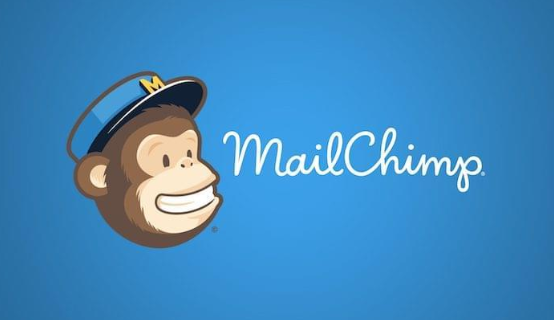
In the spirit of Big Changes, they decided to take it one step further and offer a free forever plan.
This made them a “freemium” service, where customers could get the basic features at no cost, but had to sign up for the more premium stuff.
Offering a freemium service allowed their customers to get to know the product and build trust before deciding to sign on for a contract.
The result? As of 2018, they’re raking in over $400m a year in revenue.
Final Thoughts
Want more sales? Download Growbo’s [thrive_2step id='18964']11-Point Perfect Sales Funnel Checklist.[/thrive_2step]
Consider this: the average person sees 4,000+ ads a day.
That means that the last time you picked up your phone, you probably scrolled past dozens of ads in a matter of minutes.
Can you recall even one of them?
I know I can’t.
In today’s world, we see so much content that we don’t even notice it anymore.
It’s easy for people to get stuck in your pipeline when you’re one of 4,000 businesses trying to sell to them.
From attracting and engaging, to nurturing, to actually making the sale, there are dozens of ways they can get bored or confused and slip between the cracks.
If you can identify where your pipeline is getting jammed up, that’s half the battle.

Using the tips I’ve provided, you should be able to get those leads flowing again in no time.
Do you know where your leads are getting stuck? How do you plan on fixing it?
Want more sales? Download the [thrive_2step id='18964']11-Point Perfect Sales Funnel Checklist[/thrive_2step] or invest in our Sales Funnel Blueprint.













